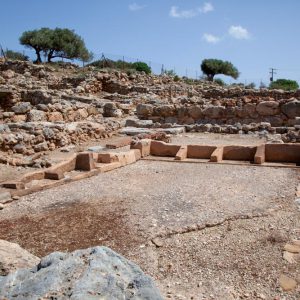Gournia is the site of a Minoan palace complex on the island of Crete, Greece, excavated in the early 20th century by the American archaeologist, Harriet Boyd-Hawes. The original name for the site is unknown. The modern name comes from the abundant hollow vessels found all over the site.
From pottery finds in the Sphoungaras area it is known that groups of neolithic people were settled in the area around Gournia in the period up to 3000 BCE, that is to say, the Late Neolithic period. The next evidence we have for settlement in the area dates to 2500 BCE in the Early Minoan period. It is almost certain, however, that the area was continuously inhabited during the intervening 500 years; it is just that no finds have been made yet to establish this.

















